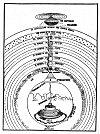
Sacred Texts Earth Mysteries Index Previous Next

COLUMBUS WAS OF GENOA a century after Dante had died at Florence. Probably he had never read his countryman's Divina Commedia; even if he had, he might have seen little of value or significance in Dante's cosmology. Dante had one, however, and his scheme brought back into modern times, that most ancient of the figures of Earth, the hills of the gods, the antipodal mountains.
But, in Dante's Earth-figure also, as in Columbus's, the mountains have shifted. If Columbus, for some strange reason--and his reason is not at all clear--had put his mountain of Paradise at the western end of the Earth, Dante's two mountains give a still odder figure. In his Paradise Found, Dr. Warren has worked out this construction of Dante's Earth, showing that the Mountain of Paradise has slipped all of 30° below the equator. He bases this construction mainly on a few lines regarding the location
of the Mountain of Purgatory (Purgatorio, Canto iv, 67-70): "Zion stands with this mountain in such wise on the earth that both have a single horison and diverse hemispheres;" and he adds: ". . . no careful reader of the Divina Commedia can fail to see that its 'Mount Zion' and the Purgatorial Montagna malagevole altissima et cinta de

FIGURE 90. The Earth of Dante.
a. City of Jerusalem. b. Mountain of Purgatory. c. Inferno within the Earth.
(From Paradise Found; William Fairfield Warren, 1885.)
mare are simply unrecognised 'survivals' of prehistoric thought--antipodal world-mountains once situate at the poles, but here relocated to suit the demands of sacred mediæval geography. They are the Su-Meru and Ku-Meru of India figuring in Christian poetry."
Another construction of Dante's universe is given (Fig. 91), from Studies in the History and Method of Science, edited by Charles Singer. It is Caetani's diagram of Dante's Hell, Purgatory, Earthly Paradise and the nine Heavens. Dante describes Hell as a funnel or inverted cone descending in nine diminishing whorls through the

Click to enlarge
FIGURE 91. Dante's Scheme of the Universe.
Slightly modified from Michelangelo Caetani, duca di Sermoneta, La materia della Divina Commedia di Dante Alighieri dichiarata in Vi tavole, Monte Cassino, 1855.
(From Studies in the History and Method of Science, ed. by Charles Singer, 1917, Vol. I, Fig. 4.)
hemisphere until the centre is reached, which is also the centre of the universe, and is situated just under Jerusalem, the centre of the habitable Earth. Or, according to Caetani, he pictures it as a circular mountain, cone-like. Purgatory, Dante places at the antipodes, that is, on an island in the ocean of the uninhabitable Earth. From this island springs a mountain ascending in a series of stages up to the summit on which is Eden, the Earthly Paradise, home of the First Pair. Paradise includes all the spheres of heaven, through all of which Dante ascends, finding himself always on the planet that governs each sphere, until at last the Empyrean Paradise is attained, which crowns the universe.
Two regions, of air and of fire, must be crossed before the sphere of the Moon, the first star, which bounds the region of fire, is reached; and on the lower right-hand quarter of Earth is the dark forest in which Dante spent a night before he began, or in which he began, his journey. At its end he is at the foot of a hill, confronting three great beasts, from whom he is rescued by Virgil, who is to be his guide through Hell and Purgatory. The poets enter the Inferno at twilight--a world of eternal night whose ruler is the Moon. They go through the ten Pits until in the very centre of the Earth they see Lucifer, its king, at this centre of gravity, encased in eternal ice.
The passage through the centre of Earth is one of the greatest difficulty, and above it is ocean only, except for the Island of Purgatory. This division of land and water is explained to Dante thus: When Lucifer fell, all the land which existed in the mysterious hemisphere fell with him,
and "fled for fear of him" escaping in what way it might around the globe, settling finally in the inhabited hemisphere. It is possible that the Earth in the interior fled also, but in the opposite direction, to form an island of land in the Purgatorial hemisphere. But, between land and land, there was left an empty space, and up this space they might climb to the island of refuge. Then comes the ascent of the stages of Purgatory to Paradise, and the flight through the heavenly spheres, until at last from the Heaven of the Stars the universe lies spread out under their feet, and Dante sees below him the purgatorial Earth, heart of the cosmos, "small and round as a threshing floor."